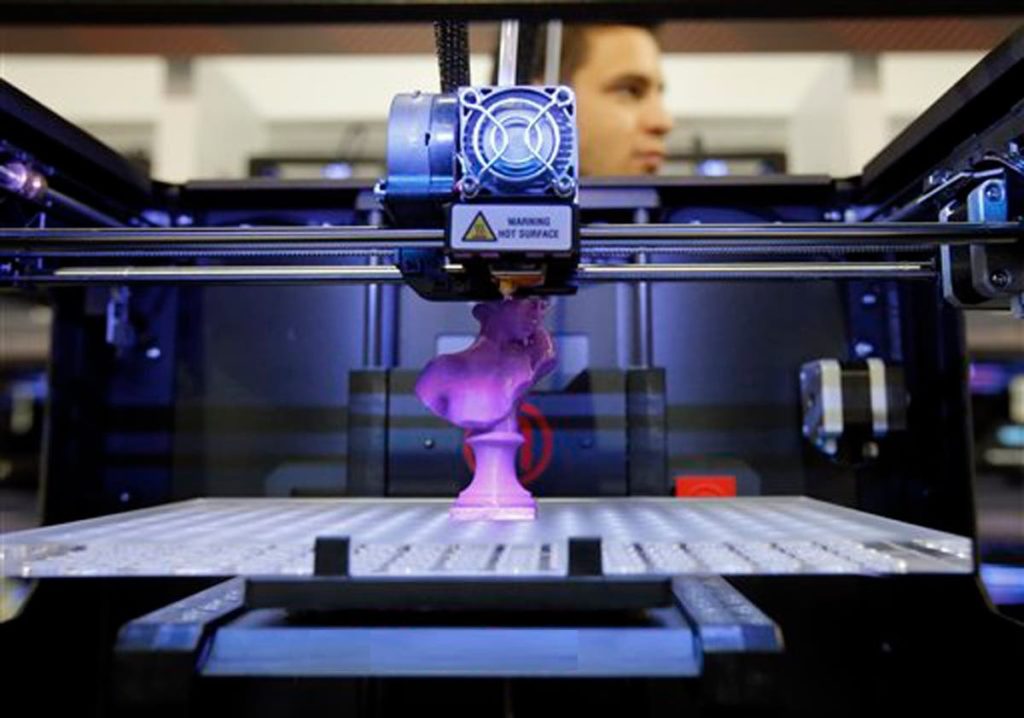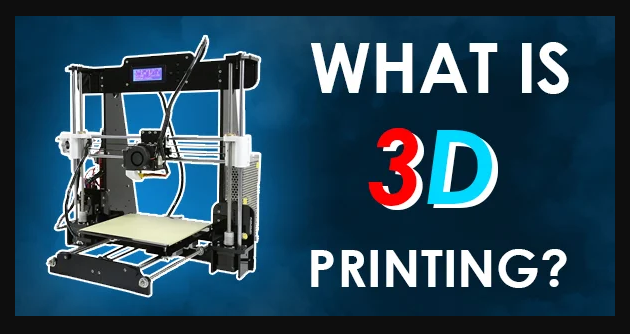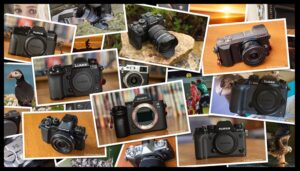
3D printers are machines that build three-dimensional objects by printing successive layers of material. You can think of them as being sort of like an inkjet printer, but instead of spraying ink onto paper, the 3D printer sprays hot plastic filament on top of a spinning platform. The object is built one layer at a time until the machine finishes.
Some people have referred to 3D printing as “the next Industrial Revolution.

3D printing has created a great revolution in the modern world by enabling the production of just about any design that fits into its build volume, offering us all the to print any item, tool, or equipment that we may need by just pressing a key. It has opened up the possibilities of making natural objects out of many materials – plastic, metal, even chocolate!
This technology is especially relevant for people interested in prototyping their products or creating custom designs for artistic or personal use. It can also be used by manufacturers who want to create objects with unique shapes or properties that can’t be made with existing tools.
How Does 3D Printing Work?
There are many different types of 3D printing, but the most common technology used today is called Fused Deposition Modeling (FDM). In this method, a plastic filament is fed into a machine and melted. Then the molten plastic is deposited onto a moving platform and allowed to cool and solidify. The platform then moves down, and the process repeats, layer by layer, until an object is formed. Some machines can print with multiple materials by using more than one extruder for the different filaments.
3D printing machines use computer models to build objects on top of each other, producing objects of virtually any design as long as they fit inside the machine’s build volume. By printing an object layer by layer, the thickness of each layer can be varied to create objects that are smooth or rough, solid or hollow.
The 3D printer has replaced the power drill, vise, and lathe as the primary tool in many design studios. With it, you can construct things almost exactly as you want them, without any waste of material. How? Well, thanks to its ability to build three-dimensional objects, it cannot be broken down into its parts.
Examples of 3D Printing
3D printing has been used by students, hobbyists, and inventors since the late 1980s. Over the past 20 years, there has been a massive proliferation of 3D printers. In 2013, 3D printing was used for over 200 million products around the world. Advances in technology have enabled 3D printers to produce even more complex objects with a wide variety of parts and materials.
3D printers have been used in various ways: prototyping tools to create new parts for mechanical, electronic, or product design; rapid prototyping tools to produce functional parts for rapid-prototyped products; and fast manufacturing tools to create custom parts from almost any material.
In this article, we will present a few examples to show how 3D printing has been applied to real everyday problems. 3D printing is not a magical tool that can do anything you want, but it has been used in some pretty cool ways.
1. Food
Everyone loves food, and everyone loves pizza, but have you ever heard about a 3D printed pizza? Probably not. But the idea arrived in November 2014 when a group of Italian designers created a project called Foodini – a kitchen appliance for making designer food. The machine is essentially a 3D printer that is attached to an ordinary kitchen counter. A computer program then controls the printer and generates the design of your pizza. For example, if you want, you could put cucumbers all over the top of the pizza or make it with 4 different kinds of cheese. As far as I know, Foodini (the machine) was not successful enough to sell in stores. But the website still exists for people to tinker with their designs!
2. Lithography
Lithography is printing patterns onto paper, film, or other surfaces by using a photopolymer plate. The technique has been used since at least the early 1800s, but with the advent of 3D printing, the technology is becoming more popular.
The digital nature of 3D printers makes it possible to print on almost any type of material. Plus, the availability of large quantities of new materials means that previously impossible applications are now simple to print on nearly any surface.
Recently many universities have joined in adding 3D printing to their curriculums. Purdue University, Michigan State University, and the University of Pennsylvania have all added classes in 3D printing to their academic schedules.
3. Medical Modelling
3D printing is a great way to create a full-sized model of a patient’s anatomy. So far, most medical 3D printing has been used primarily for orthopedic surgical procedures. However, as medicine is progressing rapidly, there is no reason this technology can’t be used for other areas as well. In 2014, the Mayo Clinic used 3D printers as part of their medical training program for interns and residents focusing on orthopedic surgeries.
4. Bicycles
When building up an original bicycle, you can’t always get exactly the parts you need to make it perfect. So some people like to print out the frame and then add wheels, tires, handlebars, and even a seat – just the right amount to build their dream ride. In 2014, a group of students from MIT decided to design a bicycle that could be printed out in just about any size, from full-sized tractors to tiny children’s bikes. They called this technology “Personalized Bicycle Printing.” But if anyone can afford a 3D printer and enough materials to build themselves a custom bike, I would surely love one!
5. Medical Implant
I can’t imagine life without my hearing aids. But imagine for a minute what life would be like if your hearing went out at the most inopportune time, leaving you unable to hear anything. The idea of having a 3D printed replacement might not be so bad after all! A group of researchers from the University of Sydney has been developing an implant fabricated through 3D printing technology that could be used to replace damaged or diseased inner ear tissue. They can scan CT, MRI, and even ultrasound images of the inner ear and use this information to “create living tissue using a 3D printer.” They have created ears with tissues, bone structures, and soft tissue to test their implants.
6. Energy Saving
When thinking about energy conservation, you probably think of expensive and complicated solar panels and windmills. So what about a 3D-printed house? An architect in the Netherlands named Nico de Krom pointed out that because 3D printers can create almost anything out of virtually anything, they could also be used to produce energy-efficient construction materials.
De Krom’s goal is “to demonstrate how 3D printing can be used to build the optimum type of house that is both cost-efficient and sustainable.
3D Printing Industry

3D printing is set to become a $15.7 billion industry by 2020 and is growing at a rate of 24% per year. This growth in popularity for 3D printing has been driven mainly by the exponential advancements in their technology over the past decade. You can go out today and purchase a personal 3D printer for under $300 if you don’t want to invest in a commercial unit.
3D printers have been used for many projects that can be split into two categories: personal and industrial applications.
Personal 3D printing involves printing on yourself or your loved ones! This is one of the most common uses of 3D printers. You can print out the perfect replacement for a missing tooth, a breast augmentation, a new set of ears, or even a 3-D printed prosthetic hand.
Industrial 3D printing is where the benefits are found in cost savings and time savings. You can create prototypes faster, more accurately, and with higher quality. Plus, you can use all kinds of new materials to improve strength, appearance, and durability.
One of the most exciting aspects of 3D printers is their versatility – they are capable of being programmed to create almost anything.
Types of 3D Printing Technologies and Processes
There are two main types of 3D printing technologies: Additive and Subtractive.
A. Stereolithography (SLA) Printing
Stereolithography is the oldest technology available for 3D printing. It uses focused ultraviolet light to build solid objects layer by layer, much like entombing an object in a vat of wax or resin. The UV light “prints” out the object on a photopolymer resin, creating an object that has almost no porosity. This makes it ideal for creating large items like prosthetic limbs, replacement organs, and even airplane bodies. However, the property that makes it great for creating large objects also makes it weak when it comes to supporting weight. If you need to attach the thing to anything, you have to use another material.
B. Selective Laser Sintering (SLS)
Selective laser sintering is similar to stereolithography in that it uses a focused laser beam or an electron beam to create 3D objects. Instead of using liquid resin-like stereolithography, it uses powder materials like nylon or metal. It works by binding the material together with heat and pressure instead of melting them together. As a result, SLS is the most common technique used when creating large objects like jet engine parts and medical implants. It can also be used to create smaller items, such as jewelry and dice.
C. Fused Deposition Modelling (FDM)
Fused deposition modeling is the most popular and accessible technology in 3D printing today. Most people are familiar with it because it has been used to rapidly prototype plastic models for years. However, its popularity has increased dramatically in the last few years because it is also made from plastic instead of metal or other materials. This makes it ideal for hobbyists who want to go beyond basic printing techniques to produce more complex items. Some of the most commonly used FDM technologies include:
¤ Stratasys: Maxum and Fortus series printers
¤ Organovo: NovoGen and NovoGen MMX series printers
¤ 3D Systems: Projet and Projet Plus series printers.
D. Laminated Object Manufacturing (LOM)
LOM is a unique class of 3D printing that uses a heated roller to compress layers of powdered material into an object. This process usually requires support materials or adhesives, although it is possible for the layers to be held together without external support. LOM is most commonly used to create three-dimensional art, but it can also make some industrial products like toys and parts for robot arms.
3D Printing Materials
3D printing is not just about plastics! Because of the vast array of materials available, you’re sure to find one that works for your needs. Below are some of the most commonly used 3D printing materials:
¤ Polymers:
These are highly versatile and can be used with any 3D printer. Polymers are solid and lightweight, making them ideal for applications like prosthetics and biomedical designs. They work by binding together with heat under pressure instead of melting the material together like traditional methods.
¤ Thermoplastics:
These are the most common type of thermoplastic, and they can be used at elevated temperatures. They are best for creating prototypes because they can be melted and fused to create a solid structure. Some examples include ABS, nylon, and PLA.
¤ ULTEM 9085:
An engineering-grade thermoplastic that has a higher heat tolerance than most plastics available for 3D printing. It is one of the most robust 3D printing materials available due to its high-density fiber structure. This makes it suitable for applications in aerospace, automotive, and military vehicles. ULTEM 9085 is also ideal for laser sintering models because it has a high laser energy absorption rate.
¤ Metal Alloys:
It would be a mistake to think that 3D printing is limited to plastics. There are many different types of metals, alloys, and materials that can create parts for automotive, aerospace, and medical applications. The most commonly used metal alloys include:
¤Titanium:
In aerospace applications, titanium is perfect for creating smaller components with a higher strength-to-weight ratio. Since it’s lightweight, it’s ideal for making small parts that weigh less than 100 lbs. You can also use titanium in prosthetics due to its high heat tolerance and corrosion resistance.
¤ Steel:
Steel is a great choice when you need a material with high mechanical resistance and toughness. It can also be used for radiation shielding because of its good heat resistance.
¤ Brass:
Brass is a great option where high thermal conductivity is needed due to its copper content. It is also ideal for precision machined parts because it’s easy to work with.
¤ Aluminum:
Because aluminum can be formed into thin sheets, it’s widely used to create lightweight parts like aircraft bodies and struts in the aerospace industry. Because of its strength and thermal conductivity, it’s also commonly used in the automotive industry.
¤ Nylon:
This synthetic solid polymer is used whenever you need something rugged, lightweight, and able to withstand high temperatures up to 300 degrees Celsius (572 degrees Fahrenheit).







